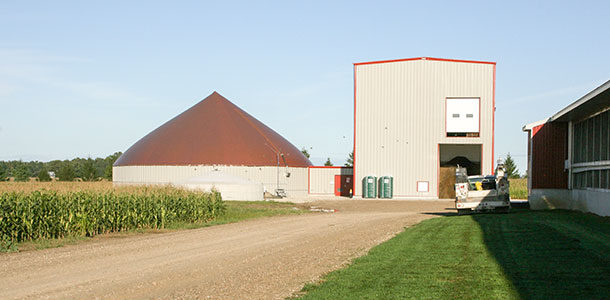Anaerobic digesters are being more widely utilized on large dairy farms to produce energy from biogas and to stabilize solids (i.e., reduction of volatile solids, pathogens and weed seeds) for use as animal bedding or soil amendment.
A number of anaerobic digester technologies are available, but regardless of the technology, one of the most important performance and economic drivers is the appropriate sizing of the anaerobic digestion system.
The first step for correctly sizing a digester is to understand the quantity and characteristics of manure and water sources from the farm, which can include raw manure, parlor water, cleanup water, misters used in the summer, etc. Efforts should be taken to minimize the amount of water used on the operation, as this will also reduce the size required for the anaerobic digestion system.
Depending on the technology, anaerobic digesters can typically handle between 2 and 13 percent total solids (TS), which can require dewatering the manure prior to digestion or only sending the higher strength wastes (i.e., high solids content) to the digester.
The size of the digester is then calculated based on how long the manure needs to remain in the digester for adequate digestion. The length of time the manure stays within the digester is known as the hydraulic residence time (HRT), whereas the length of time the solids stay within the digester is known as the solids residence time (SRT).
When dealing with a typical complete mix or plug flow digester, HRT and SRT are the same because whatever manure or water is pumped in is eventually pumped out, with the assumption being that there is no accumulation of solids in these systems. The HRT (or SRT) for completely mixed or plug flow digesters is generally in the range of 20 to 25 days.
Alternatively, in attached growth systems, the solids, which harbor the microorganisms that carry out the conversion of manure into methane, form biofilms on media within the digesters. Thus, these solids (or microorganisms) accumulate within the system, resulting in a decoupling of the HRT and the SRT, with the SRT being longer.
The potential benefits of this longer SRT are either a reduction in the required digester size or greater digestion efficiency for the same size digester. If one of the goals of the dairy farm is to generate consistent quantities of biogas (i.e., methane) to help offset electrical usage with the aid of a generator, more consideration must be made for the SRT. However, because the HRT and SRT are the same for complete mix and plug flow digesters, the cost of a larger tank must be balanced with the additional gas production. Attached growth systems allow for an increased SRT and gas production in the same tank size, but would require a media for the microorganisms to be attached.
Sizing considerations should also be given to co-digestion of offsite wastes, such as fats, oils and greases (FOG) and straw, which can result in approximately five times more methane production than manure. However, inconsistent feed stock quantity and quality can result in digester upsets and downtime.
For optimal digestion within all of these systems, additional considerations should also be given to maintaining a temperature in the mesophilic range (95ºF to 105°F) and providing adequate mixing.
In summary, correctly sizing an anaerobic digester is critical in meeting the dairy farm’s goals and objectives, and is also the major driver for determining if the anaerobic digestion technology is economically feasible. PD
John F. Katers and Ryan M. Holzem are from the University of Wisconsin – Green Bay Department of Natural and Applied Sciences.
PHOTO
Photo by Karen Lee.






